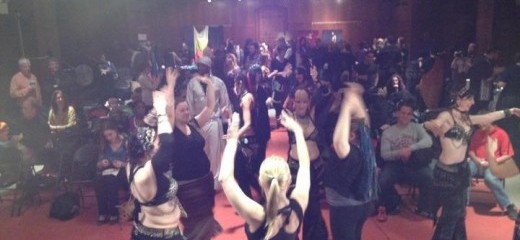
Photo: Shushanna Productions
Philly Hafla Throws a Bellydance Party
By Jim Rutter
Much of Philadelphia’s vibrant dance community operates in niches unnoticed and underappreciated by general dance-going patrons. The local bellydance scene falls into this category.
While some Philly restaurants and clubs (Marrakesh, Byblos) feature performers on weekends and at special events, and a number of schools teach bellydancing for both exercise and performance, few bellydance touring or professional companies perform in Philadelphia.
However, as Shushanna Productions’ second Philly Hafla proved, the city’s bellydance community is richly varied and versatile. On April 1, fifteen local performers and troupes presented short pieces at the First Unitarian Church, 2125 Chestnut Street.
Many of the performers and troupes highlighted the diversity of bellydance as a genre. Kelebek blended pantomime and hip-hop into modern bellydance style, accentuating her black and gold halter and pants with a top hat that she waved in patterns reminiscent of a Janet Jackson video. South Jersey troupe Shanti shuffled back and forth on flat feet with arms aloft and minute permutations of hand gestures.
New Jersey troupe Zedoary’s five dancers covered most of the stage in their cabaret bellydance style performance. The dancers used their long, layered skirts as props, holding the fabric as if it were a dance partner, turning and sashaying as they moved across the hardwood floor.
Two of the evening’s works thrilled the audience with sword dancing (Raqs as sayf). Duo Eye of Isis (Jawhara Edwards and Christina Bahrt) each balanced scimitars on the crowns of their heads. In their fascinating piece, they moved seamlessly through a series of poses: they swung their hips outward, extended a leg horizontally, then bent forward; later, they propped themselves horizontally on one elbow on the floor before moving into back bridges. Throughout, the swords never wavered, but remained motionless, as if suspended on invisible wires.
Local bellydance expert Habiba enacted a Tunisian pot dance (Raqs al juzur). After setting a tall, curved-handled water pot at the corner of the stage, she held a scarf outward and moved in a circle, pivoting at the hips as she turned, waving the scarf up and down she slid along the floor on her toes. Habiba then repeated many of these motions with the pot balanced on her head, her body moving laterally as she rotated across the stage. Yet the pot stood still, like an inverted rotating restaurant that held fast while the building turned beneath it.
Three local bellydance instructors displayed their craft in solo pieces. Studio 1831 owner Valerina entered wrapped in a green cellophane cocoon over her purple bikini top and skirt (her costume crowned an evening of spectacular fashion and detailed ornamentation that saw most of the dancers wearing fitted tops and skirts or harem pants). Valerina spiraled across the stage, occasionally whipping her long mane of blonde hair forward and backward. She punctuated these movements with still poses in which she formed various winglike configurations with the cellophane sheaths (butterfly, dragonfly, bat).
Fatima and Shushanna closed the night. Brank, with gold amulets adorning her forehead and chest, rocked her hips forward and back through a blue and black sequined skirt split to the waist at each leg. Unlike many other presenters, she attempted to beguile the audience, and her virtuosic piece offered up potential for artistic interpretation.
However, the evening’s recital format precluded this need for assessment. Hafla means “party” in Arabic, and a party it was. A long table overflowed with bowls of tangerines, dishes filled with hummus, plates of Middle Eastern pastry and jugs of homemade sangria. Makeshift stalls lined the back wall; here vendors hawked bellydance jewelry, costume and crafts. (Haflas in any country include all of these elements, in addition to live music and recital presentation dancing.)
Like many of the other solo acts, both Fatima and Shushanna followed their pieces with improvised encores to the music of the house band, which consisted of alto sax, riqq (tambourine), oud (11-string lute), flute and dumbek (drum). These encores amazed with fantastic interplay between dancers and musicians; while the dancer sometimes took cues from the percussion, often she led the beat.
After each of the two acts, Shushanna opened up the floor and stage for general dancing; the house band played and the hall rose up en masse to join in its rhythms. The crowd’s exuberance proved that, like many other niche dance genres, bellydance has established a strong community following in Philadelphia.
Philly Hafla, hosted by Shushanna Productions. First Unitarian Church, 2125 Chestnut Street. April 1.
By Jim Rutter
April 24, 2012

